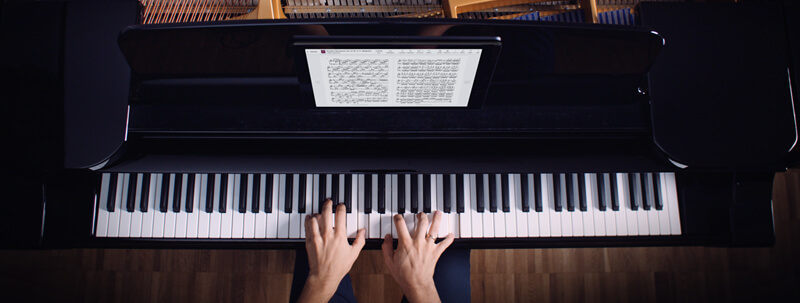Exploring the Baroque Age: 10 Crucial Pieces for Piano

Jump to section
You get a fascinating chord poster + exclusive content!
Canon in D
Canon in D is a masterpiece by Nuremberg composer Johann Pachelbel. It is renowned for its serene and romantic ostinato base, over which a canon unfolds in a progression of 28 sequences, which will captivate any piano player with its harmonic simplicity and emotional depth.
Air on the G String
Air on the G String is a piece by Johann Sebastian Bach. Originally part of the Orchestral Suite No. 3, the Piece became famous for its adaptation for violin and piano. Particularly notable, the piano arrangement provides a warm and robust bass to the melody. This piece is a timeless contribution to the classical music repertoire.
Prelude 1 C Major, BWV 846
Prelude 1 C Major, BWV 846, is another masterpiece by Johann Sebastian Bach. Part of the 'Well-Tempered Clavier', it plays a vital role in piano literature, entailing a delicate, continuous, flowing stream of music that is both tranquil and refreshing. A primary piece for beginning piano players seeking to delve into the Baroque style.
La Primavera – Spring, Op. 8, RV 269
La Primavera – Spring, Op. 8, RV 269, is a distinguished piece by Antonio Vivaldi from 'The Four Seasons.' Originally composed for solo violin, it evokes the season of Spring. Piano transcriptions exist and many pianists enjoy its beautiful melodies and distinct rhythmic patterns that truly bring the spirit of Spring to life.
Here is the sheet music for La Primavera – Spring, Op. 8, RV 269!
Lascia Ch'io Pianga
'Lascia Ch'io Pianga' is a popular aria from Handel's opera, 'Rinaldo'. While originally composed for voice, its elegant melody makes it a treasured piece among piano players. The piano version beautifully emphasizes the poignant, heartbreaking expression of the song, offering complexities and technical demands that reward the player with an emotive experience. Its Baroque musicality is a valuable addition to any pianist’s repertoire.
Menuet A Major, HWV 546
The 'Menuet A Major, HWV 546' by Georg Friedrich Händel showcases the charm of Baroque music with its graceful rhythm and richly decorated melody. This piece, specifically written for harpsichord, is also performed frequently on piano, offering piano players an opportunity to delve into the harmonic complexities and intricacies of Handel's music. It is a delightful piece for any piano repertoire.
Minuet G Minor, HWV 434/4
Minuet G Minor, HWV 434/4 by Georg Friedrich Händel is a classical work admired for its solemn character. The piece is steeped in emotional depth and complexity accessed via the piano. It presents a remarkable blend of mastery and expressiveness, making it a valuable addition to the repertoire of any piano player.
Orpheus and Eurydice: La Plainte d'Orphée
Orpheus and Eurydice: La Plainte d'Orphée by Christoph Willibald von Gluck is a soulful and poignant composition. The piece beautifully uses the piano to echo Orpheus's lament, making it a significant work for piano players studying expressive and emotive playing.
Here is the sheet music for Orpheus and Eurydice: La Plainte d'Orphée!
Sonata in F Minor, K466 (L.118)
Sonata in F Minor, K466 (L.118) by Domenico Scarlatti is a stunning piano piece characterised by its deep, emotional resonance. As a pianist, you'll find rhythmic complexity and rich harmonic language in this sonata. The interplay between hands challenges your skills, revealing the piano's expressive power.
Here is the sheet music for Sonata in F Minor, K466 (L.118)!
Le Tambourin
The song 'Le Tambourin' by Jean Philippe Rameau is a lively and dynamic composition. Known for its complex piano arrangement, it captures the essence of Rameau's style, offering an exciting challenge for piano players.
Conclusion
Integrating these 10 Baroque pieces into your piano repertoire is a formidable step towards mastering this significant music period, providing a holistic view of the Baroque era's complexity and historical significance. Each piece provides unique challenges and insights, reinforcing your understanding of Baroque stylistic nuances, and furthering your development as a pianist. Enhancing your repertoire with these pieces will undeniably refine your ability to interpret and convey the profound emotions and intricate rhythms that define Baroque music.


